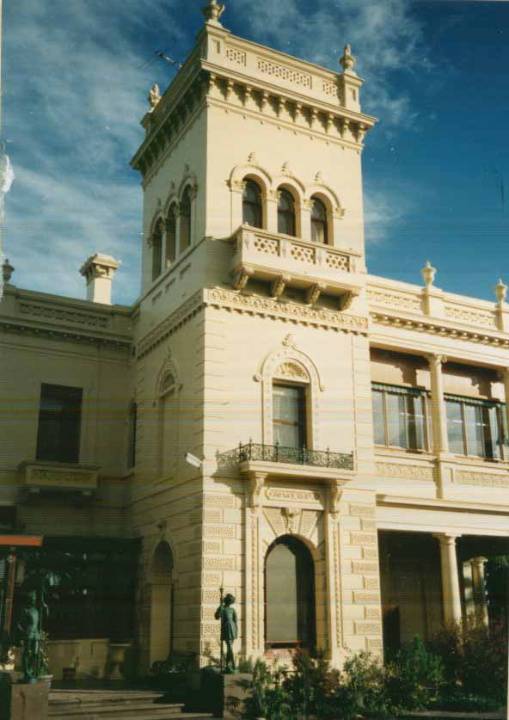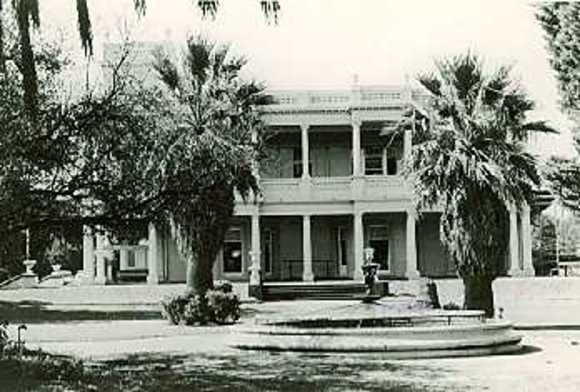| Back to search results » | Back to search page » |
|
Kamesburgh House & Garden
Other NameANZAC Hostel Location74 - 104 North Road,, BRIGHTON VIC 3186 - Property No B0498
File NumberB0498LevelState |
|
Statement of Significance
The 20 room villa residence, Kamesburgh, was built for the merchant William Kerr Thomson in 1873-4 on part of Dendy's Crown Special Survey. Lloyd Tayler was the architect and David Mitchell the contract builder. With extensions, the building was cited in the 1884 rate book as of 40 rooms. File note 25/06/2012: G13075 (Kamesburgh Garden) amalgamated & filed with B0498.
The property remained a domestic dwelling until the ownership of the prominent pastoralist, financier and politician Duncan McBryde. In 1918 negotations by the Repatriation Department led to purchase from him by the Melbourne real estate agents- the Baillieu brothers, who made a gift of the property as a care and rehabilitation centre for ex-servicemen. It was renamed Anzac Hostel and formally opened on 5 July 1919 by Sir Arthur Stanley, Governor of Victoria. First floor extensions were added at the rear and a lift installed. Administration was vested in the Red Cross.
A monumental structure on the grand scale, with colonnaded verandahs of the Tuscan and Ionic orders, its main entrance is topped by a tower and guarded at the base by two cast iron figures. Decorative elements of Anzac Hostel extend to vermiculated quions, balconettes, stained glass windows, urns and encaustic hall tiles, with cast iron balustrade panels to the main stair.
Sale of 6 acres in 1927 reduced the grounds to yet extensive 6 1/2 acres, still matching the scale of the building. The original cast iron gate posts and gatehouse introduce the scene. Anzac Hostel is a key element of Brighton streetscape, and solidly set in Melbourne's financial, philanthropic and social history.
Classified: 13/11/1958.
Garden significance: Kamesburgh (now Anzac Hostel), the residence erected in 1873-74 to a design of noted architect Lloyd Tayler and the garden laid out from this time, the mansion enlarged in 1884, the property sold in 1918 and used for a repatriation hostel and, with slightly truncated grounds, still retained for that use, is of State significance:
- as a city mansion garden; its main attributes are its large allotment (despite reduction from its former size) and mansion residence, gate lodge, entry drive, formal terrace, fountain, path layout, service areas, orchard, sunken garden, flower beds, summerhouse and mature plantings;
- for its collection of mature plants, including several trees individually listed on the National Trust's Register of Significant Trees; the trees at Kamesburgh are among the best collection of mature species trees in a Victorian private garden;
- as a reminder of the World War I repatriation movement, a use which the site has retained since 1918 and which has permitted this city mansion to be retained with relatively sympathetic modifications; the repratriation era is also represented by a Crafts/Recreation Hall of 1919, thought to be the earliest purpose built structure in Victoria erected for war repatriation purposes; - for its streetscape qualities, including mature planting, gate lodge and gates, and long frontage to North Road (itself important historically as the northern boundary to Dendy's 1840 Special Survey);
- for its aesthetic qualities, resulting from views into the garden (especially from North Road), long views within the garden, especially to and from the mansion, the combination of mansion and garden, the mature trees, the shrubberies and flower beds.
ANALYSIS: As a City Mansion Garden:
The most comparable gardens are Rippon Lea, Stonnington, Raheen and Como. The garden at Rippon Lea is in a class of its own and of undoubted national significance. Stonnington, Raheen and Como, like Kamesburgh, have all suffered through the loss of land in the interwar period, but all four retain enough of their early layout and planting for their gardens to be considered of statewide significance. In the case of Stonnington, the occupancy of the Victorian Governor and the considerable architectural significance of the mansion raise its level of significance to national.
Government House is another city mansion but is of a higher order of significance than Kamesburgh and considered of undoubted national significance.
In the case of Como, historical and architectural significance also raises the overall level of significance of the property to national. Whilst both Raheen and Kamesburgh have considerable historical and architectural significance they can only be considered as being of statewide significnce. Other city mansion gardens which have been considerably reduced in size include Tintern and Miegunyah, both of regional significance. It should be stressed that Melbourne has very few city mansions which retain large allotments.
For its Collection of Plants: The mature planting at Kamesburgh comprises a rich collection of tree species popular during the nineteenth century. Due to their age and ample room for development, many of these trees have grown into outstanding specimens. Kamesburgh is also one of a very few gardens to still have an extensive orchard of peaches, plums, locquats, quince, pears, apples and citrus trees.
As a Reminder of the WW1 Repatriation Movement: Other sites in Victoria which represent the repatriation movement include Macleod Repatriation Hospital, Bundoora Repatriation Hospital, Caulfield Repatriation Hospital, and a building in South Melbourne, south of Victoria Barracks. There may be other rural siteswhich are unknown. The Victoria Barracks building dates from 1937 and is principally significant as an example of art deco architectural influence in Victoria. Bundoora is perhaps the most comparable site and comprises a large former private mansion set in spacious grounds. The Crafts/Recreation Hall at Kamesburgh (1919) is thought to be the earliest purpose built structure in Victoria erected for repatriation purposes.
For its Streetscape Value: Kamesburgh is located on one of the principal streets on Melbourne's bayside suburbs - North Road - which was created in 1840 and the northern boundary of Dendy's special survey (the others being South Road and Boundary Road). The gate lodge and fence are still intact and provide an appropriate street presence for the mansion, set back from the road but able to be glimpsed through the landscaping. The mature landscaping of Kamesburgh is complemented by the mature avenue of trees in North Road.
Garden Classified: 15/09/1993
Group
Parks, Gardens and Trees
Category
Garden Residential





